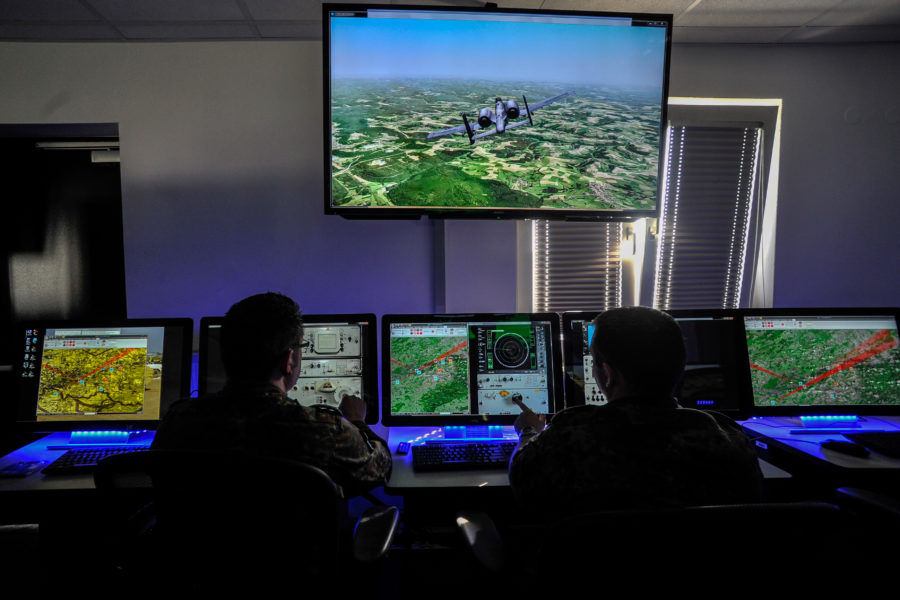Air Force leaders want Airmen to train as they fight, but the barriers to executing true distributed mission operations are everywhere: simulators and networks need to communicate, combat systems need to talk to simulators, international partners need access to one or another component of the live, virtual, and constructive training continuum.
The Air Force is looking for answers. The answers may lie in a legacy program under the Defense Advanced Research Projects Agency, that enabled Navy training with joint and allied partners. Called the Navy Continuous Training Environment (NCTE), HII developed and matured in partnership with the Navy, it offers a comprehensive toolset for solving the Air Force’s LVC training challenges, said Michael Aldinger, vice president and Air Force lead for HII’s LVC Solutions Group.
“The Air Force and Navy DMO programs are focused on ‘Train as you Fight,’” Aldinger said. “The concept is to prepare the warfighter to execute their missions successfully. The training systems we integrate are concurrent with the platforms in the field, so our distributed architectures enable the warfighter to train with the teams they’re going to deploy with, preparing them to successfully conduct their missions.”
LVC integrates—live action operators, others operating in simulators (virtual), and constructive simulations injected into both training domains. The goal is the most realistic training possible, so when warfighters find themselves in the middle of action, they are already well versed in what to do.
“A critical aspect of integrating these domains together is developing interoperability standards based on training objectives,” Aldinger said. “HII’s enterprise approach utilizes common standards, tools, and procedures for the entire spectrum of training, so it can scale from the unit level all the way to the joint and even coalition level. It’s one single set of tools to govern all levels up to and including very large scale.”
An LVC enterprise training architecture provides an interconnected network that enables effective distributed mission operations.
“The value of distributed mission operations is that disparate simulators located at bases throughout the world are interoperable and interconnected, providing our warfighters the means to train together as a team from multiple locations. That is why DMO provides an ideal solution for achieving warfighter readiness,” Aldinger added.
HII developed its technology and enterprise architecture approach for more than a decade developing the NCTE.
“In 2021, the Navy executed a large-scale, two-week exercise using our LVC enterprise approach with 25 ships and 25,000 participants, including live aircraft and simulators, live ships at sea, and live ships dockside that were all pulled into one, single event,” Aldinger said. “This capability enables training at the unit level for ships, small team training for air, joint training across services, and coalition partners like Australia, Japan, and UK, all together in large-scale exercises.”

An enterprise architecture that embraces open-source solutions is critical for overcoming the current limitations to speed and agility that are essential for effective warfighter training.
“HII’s enterprise approach to LVC removes the proprietary aspect of existing solutions,” Aldinger said. “The Air Force has been clear that proprietary solutions impact agility and speed because it keeps solutions in the hands of the few. That limits innovation because only one specific contractor can evolve a designated program to solve a problem.”
But nonproprietary solutions are better aligned to the stated goals of Air Force leadership.
“Nonproprietary solutions are important because everyone has access to the data,” Aldinger said. “With the disparate solutions out there today, everyone is developing their own solution, and you’re not all building toward a common goal. That limits who can contribute effectively. If we want to realize the innovation the Air Force is requesting, all-inclusive stakeholder involvement is going to be critical.”
Nonproprietary solutions enable new and advancing technologies to be applied to distributed mission operations across the enterprise.
“DMO has evolved dramatically, but there’s so much more that can still be done with developing technologies such as AI/ML,” Aldinger said. “You hear a lot from the Air Force, ‘We need more innovation,’ and by eliminating the proprietary nature of their programs, they will get more innovation, agility, and speed, because now you have stakeholders solely focused on the warfighter and getting the right technical solutions in place.”
Everything becomes easier once there is a common interface and connecting mechanism, Aldinger said.
“With the LVC enterprise, we utilize common tools to support all aspects of the event life cycle, from training system standards compliance evaluation through to event coordination and distributed execution,” he explained. “Then, after the event is over, there are tools to evaluate the performance of the pilots. [The LVC enterprise] offers a very broad spectrum of capability that is really at the center of defining the training framework.”
This is especially critical for developing and integrating training for Fifth Generation weapons systems and platforms.
“Fifth Generation brings a whole new level of training fidelity and capability to the Air Force,” Aldinger said. “If we’re going to be successful with the integration and operations of the F-35 and beyond, we must improve testing fidelity, as well. Instead of having two separate environments for testing and training, they can unify these two into one common, high-fidelity architecture.”
That will save money across the enterprise, Aldinger said.
“An enterprise approach is going to reduce the cost of maintenance and sustainment, improve stakeholder collaboration and innovation, and focus your team on an all-domain future,” Aldinger said. “There’s going to be substantial cost savings in that alone.”
But the savings and benefits extend beyond that, as the Air Force delves deeper into developing the joint, all-domain command and control capabilities envisioned as the future of integrated joint warfare.
“The future of training is joint all domain, whether it be subsurface, surface, air, space, or cyberspace,” Aldinger said. “Today, all these domains are being trained separately and across the commands. As we head into the future, it must all be within an enterprise architecture so that we are training the warfighter and preparing them to win.”
